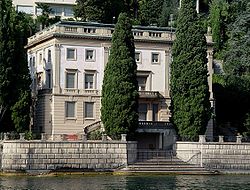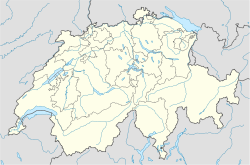- Museo delle Culture
-
Coordinates: 46°00′02″N 8°58′58″E / 46.000653°N 8.982847°E
Museo delle Culture 
Established 1985
Opening: September 23, 1989Location Via Cortivo 24-28, 6976 Lugano-Castagnola, Switzerland Type Anthropology - Ethnic Art Director Francesco Paolo Campione Website http://www.mcl.lugano.ch/ The Museo delle Culture is one of the museums that form part of the Polo Culturale of the City of Lugano.
Contents
Heleneum
Since the beginning the Museum is settled at the Heleneum, a lakeside mansion house built between 1930 and 1934 by Hélène Bieber, a cosmopolitan strong-minded lady who lived there until 1967. Between 1969 and 1971 the Heleneum hosted improvers piano classes under the artistic direction of Carlo Florindo Semini, with Arturo Benedetti Michelangeli and Franco Ferrara. Later on the Istituto Ticinesi di Alti Studi directed by Elémire Zolla and gathering archaeologists, anthropologists, art historians, philosophers, linguists, Egyptologists and Orientalists settled in the mansion house. Between 1971 and 1976 the Heleneum hosted the Istituto Dalle Molle which worked on artificial intelligence, organising seminars in collaboration with the Istituto di studi semantici cognitivi (ISSCO), attended by researchers from all over the world. The Heleneum park is a botanic gem where, thanks to a particularly mild microclimate and the lake, grow Meditarranean, tropical and subtropical plants.
Brignoni Collection
The Museo delle Culture conserves most of the ethnic art works that the Swiss Italian artist and collector Serge Brignoni collected between 1930 and 1985 when he donated them to the City of Lugano. Therefore, the collection states the link between the creative forms of the "South Seas" cultures and the artistic Avant-Gardes of the 19th century that were inspired by those objects coming from far away. The works are the result of an attentive selection which favours the best workmanship objects and is able to fully recognize the expression of a not yet civilised art. The genres and the geographical origins of the Brignoni collection works are mostly the same as those found in the leading European, North American and Australian collections from the first half of the 20th century. Moreover almost none of the “pieces” considered fundamental for the contemporary collecting is missing.
Nodari Fund and Collection
In 2006 the Museo delle Culture came to an agreement with the Government of Canton Ticino on the Nodari Fund and Collection. This agreement states that Canton Ticino, owner of the Collection and the Fund, lends to the Museo delle Culture, on a permanent contract, the whole collection and the documentary fund collected by Alfredo and Emma Nodari. The collection consists of a thousand art works and objects, two big river boats, almost 6'000 pictures, 71 documentary films and more than 60 hours tape recording, collected by Alfredo and Emma Nodari during their journeys to Africa (notably in Congo) in the '50s and '60s. The most important art works of the collection, probably are two pillars from the BaKuba royal palace in Kasai (Congo), that are placed at the entrance of the Museum.
Exhibitions
The permanent exhibition layout is designed as an imaginary geo-cultural journey through the different areas represented in the Museum collection. In every room the visitor can appreciate and understand the works on the basis of the following four themes:
- the journey to the South Seas and the “discovery” of ethnic art (viewed from an ethical standpoint). It also relates to the interior “voyage” taken by European avant-garde artists (see map 1) and the actual journey undertaken from the West towards the “farthest” East (see map 2). The intention is to point up the existence of a sort of cultural and stylistic community (koinè) that spans the creative expressions of the vast area that ranges from Eastern India to Easter Island, taking in Indochina, south-east Asia and the Hawaiian archipelago;
- the ethnos of which the artists represented in the exhibition were an integral part and which were distinguished by particular cultural, ideological and social structures. The monographs naturally correspond to the cultures best represented by the works in the museum: India, Indonesia, Borneo, Asmat, Maprik, the Papuasian Gulf and the Melanesian Island Chain, Sepik, New Ireland and Polynesia;
- a theme of particular anthropological relevance to the understanding of the world by the cultures in question (emic vision);
- the style, in several of its salient characteristics and peculiarities, developed by the cultures represented in the exhibition.
The temporary exhibitions are organised in three different exhibition cycles. "Esovisioni" deals with the theme of exotism in early 20th century photography; "Dèibambini" focuses on the pedagogical and creative relationship resulting from the encounter between children and ethnic art; "Altrarti" increases and broadens a specific art and culture expression, taking into consideration many different values. An illustrated scientific catalogue is published for every exhibition.
Activities and services
The Museum activities are based on the scientific research carried out by the Museum staff and other experts, together with museums, cultural institutions and universities worldwide. For this reason, the Museum often hosts seminars and higher education activities: lectures, refresher courses and museography and anthropology laboratories. The Library and the Archive are open from Tuesday to Friday from 3pm to 5 pm. The Library catalogue is on-line on the Sistema bibliotecario ticinese (Sbt) website. By appointment, it is possible to visit the Museum stores where there is also the Conservation and Museum technology activities Laboratory, equipped for the Museum needs and for private specific consultancies. Specialised Museum staff offer many different educational activities as laboratories for children, guided tours, conference-tours and other activities that can be customised according to the user needs. By appointment, the Museum also offer a guided tour of the mansion house and the park. Besides, the Museum offers its rooms for meeting, special events, photographic sessions and movie shots.
Bibliography
Campione Francesco Paolo (ed.), The Brignoni Collection; volume one, Art through Methamorphosis; volume two, Catalogue of Works, Mazzotta, Milan 2007. ISBN 978-88-202-1848-5 and ISBN 978-88-202-1865-2.
Cometti Marta, Guida. Museo delle Culture di Lugano, Edizioni Città di Lugano/MCL (Antropunti/3), Lugano, 2009. ISBN 978-88-7777-043-1.
Vago Valeria, In viaggio per i mari del Sud. Guida per ragazzi al Museo delle Culture, Edizioni Città di Lugano/MCL (Antropunti/2), Lugano, 2009. ISBN 978-88-7777-042-4.External links
Categories:- Lugano
- Art museums and galleries in Switzerland
- Buildings and structures in Ticino
Wikimedia Foundation. 2010.

